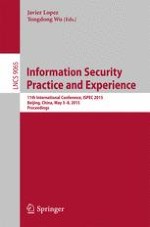This book constitutes the proceedings of the 11th International Conference on Information Security Practice and Experience, ISPEC 2015, held in Beijing China, in May 2015.
The 38 papers presented in this volume were carefully reviewed and selected from 117 submissions. The regular papers are organized in topical sections named: system security, stream cipher, analysis, key exchange protocol, elliptic curve cryptography, authentication, attribute-based encryption, mobile security, theory, implementation, privacy and indistinguishability.
